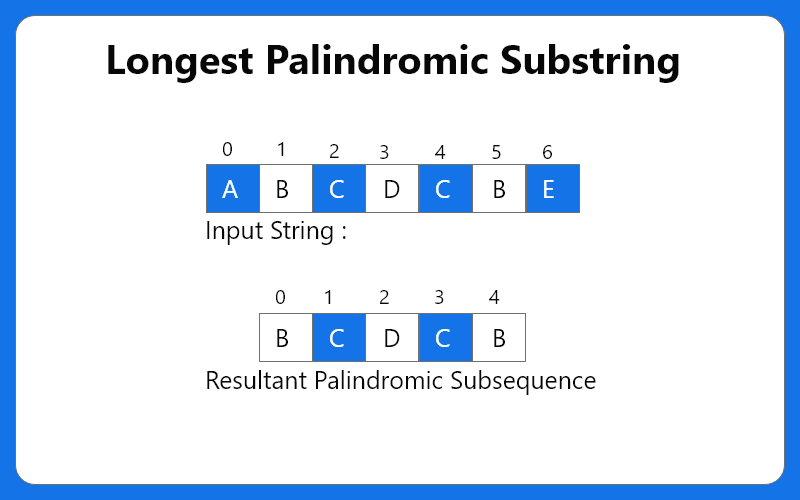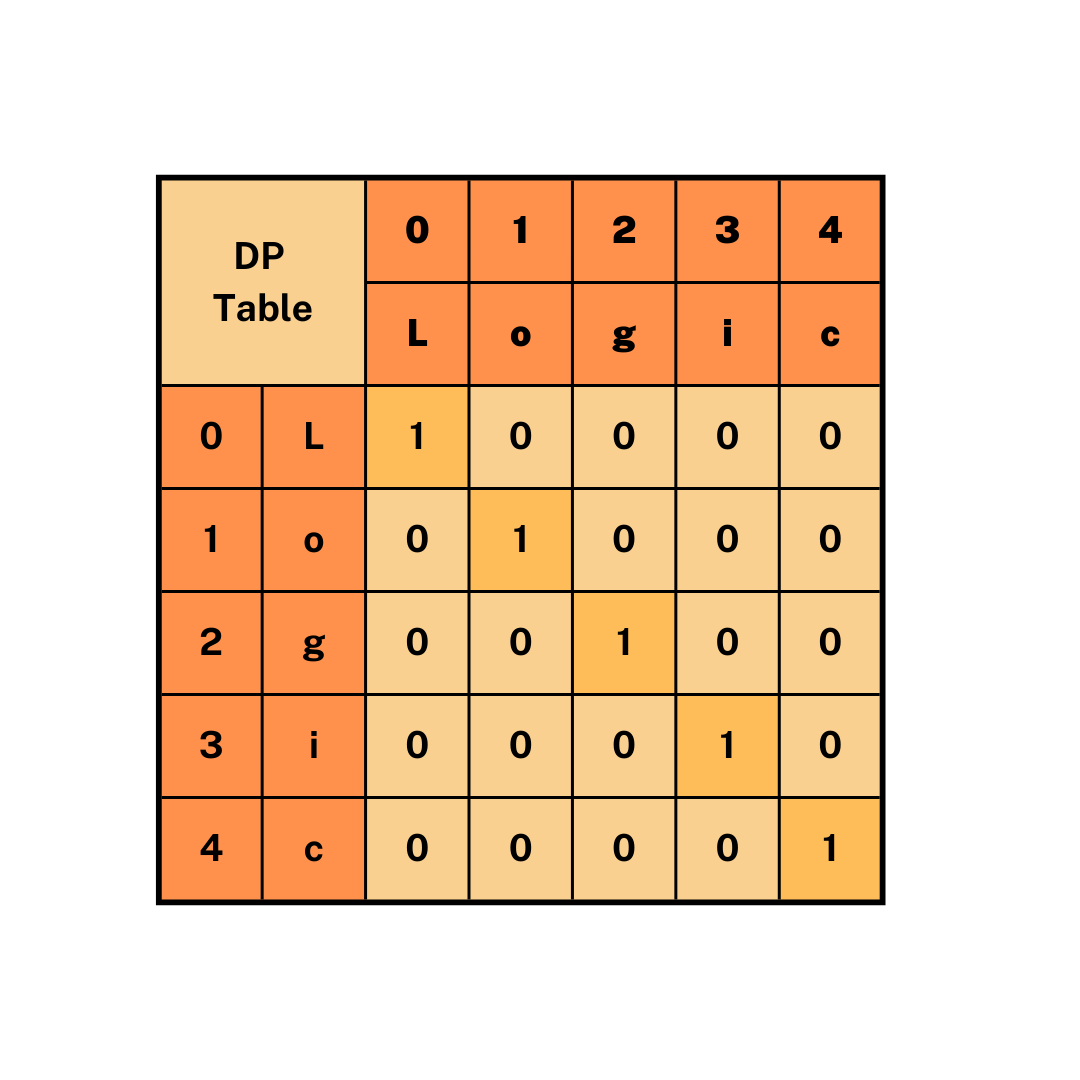Unlock the complete
Logicmojo experience for FREE
Sign Up Using
1 Million +
Strong Tech Community
500 +
Questions to Practice
50 +
Jobs Referrals
Sign Up Using
Strong Tech Community
Questions to Practice
Jobs Referrals

Find and return the longest palindromic substring in a string str of length N. Substring of string str is str[i...j] where 0 <= i <= j < len(str)
Palindrome string:
A string which reads the same backwards that is if reverse(str) = str, then str is a palindrome. If there are more than one substring then return the substring that appears first.
Input Format : The string str is the first and only parameter.
Output Format : Return the longest palindromic substring of string str as a string.

For Example,
Input : mojologiccigolmojo
Output : logiccigol
Explanation : The longest palindromic substring is 10 characters long, and the string is logiccigol.
Input : abcdcbe
Outupt : bcdcb
Explanation : The longest palindromic substring is 5 characters long, and the string is bcdcb.

We have presented two approaches to find the longest palindromic substring :
• Brute Force ApproachThe most straightforward method is to check whether each substring is a palindrome or not. To begin, run three nested loops: the outer two loops pick all substrings one by one by fixing the corner characters, and the inner loop tests if the substring picked is palindrome or not.
It is important to note that every substring of length "1" is a palindrome in this context.
We'll therefore initially keep a variable that simply stores the length of our input string and another variable that simply stores the maximum length of the palindrome we have encountered so far. Reversing a string and comparing it to the original string, or substring in this case, is a useful approach to determine whether a string is a palindrome.
Time complexity : O(n^3).
Three nested loops are needed to find the longest palindromic substring in this approach, so the time complexity is O(n^3).
Space complexity : O(1).
As no extra space is needed.
#include <bits/stdc++.h> using namespace std; void longestPalindrome(string str) { int n = str.size(); int max = 1, start = 0; for (int i = 0; i < str.length(); i++) { for (int j = i; j < str.length(); j++) { int flag = 1; for (int k = 0; k < (j - i + 1) / 2; k++) if (str[i + k] != str[j - k]) flag = 0; if (flag && (j - i + 1) > max) { start = i; max = j - i + 1; } } } for (int i = start; i <= start+max-1; ++i) cout << str[i]; } int main() { string str = "mojologiccigolmojo"; longestPalindrome(str); return 0; }
class Main{ public static void longestPalindrome(String str) { int n = str.length(); int max = 1, start = 0; for (int i = 0; i < str.length(); i++) { for (int j = i; j < str.length(); j++) { boolean flag = true; for (int k = 0; k < (j - i + 1) / 2; k++) if (str.charAt(i + k) != str.charAt(j - k)) flag = false; if (flag && (j - i + 1) > max) { start = i; max = j - i + 1; } } } System.out.println(str.substring(start,start+max)); } public static void main(String[] args) { String str = "mojologiccigolmojo"; longestPalindrome(str); } }
def printSubStr(str, low, high): for i in range(low, high + 1): print(str[i], end = "") def longestPalindrome(str): n = len(str) maxLength = 1 start = 0 for i in range(n): for j in range(i, n): flag = 1 for k in range(0, ((j - i) // 2) + 1): if (str[i + k] != str[j - k]): flag = 0 if (flag != 0 and (j - i + 1) > maxLength): start = i maxLength = j - i + 1 printSubStr(str, start, start + maxLength - 1) if __name__ == '__main__': str = "mojologiccigolmojo" longestPalindrome(str)
This problem can be resolved using dynamic programming, a more efficient variation of the prior method. To reiterate, dynamic programming works by splitting up larger problems into smaller ones and applying the output of computations on the smaller problems. The outcomes of the more manageable subproblems are retained and used.
Steps to solve the problem :
Keep a boolean table[n][n] that is filled from the bottom up.
If the substring is a palindrome, the value of table[i][j] is true; otherwise, it is false.
Check the value of table[i+1][j-1] before calculating table[i][j]. If the value is true and str[i] and str[j] are identical, then table[i][j] is true.
Otherwise, table[i][j] values is set to false.
We must fill out a table in advance for substrings of lengths=1 and lengths=2 since we are determining whether table[i+1][j-1] is true or false, therefore in the event of
If length == 1, let i=2, j=2 and (i+1,j-1) not lie between [i,j].
or, length == 2, let's say that i=2 and j=3, and that once more i+1 and j-1 do not lie between [i,j].

Time complexity : O(n^2).
Given that we need two nested traversals of the string, this strategy has a lower temporal complexity than the naïve or brute force solution,
but it is still not the best option, so, the overall complexity is O(n^2).
Space complexity : O(n^2).
The dynamic programming approach's space complexity is O because we store the results of the subproblems in a table of size n * n. (n2).
#include <bits/stdc++.h> using namespace std; // Function to print a substring void printSubs( string s, int low, int high) { for (int i = low; i <= high; ++i) cout << str[i]; } // longest palindrome substring int longestPalSubs(string s) { int n = s.size(); bool table[n][n]; memset(table, 0, sizeof(table)); int maxlen = 1; for (int i = 0; i < n; ++i) table[i][i] = true; // check for sub-string of length 2. int start = 0; for (int i = 0; i < n - 1; ++i) { if (s[i] == s[i + 1]) { table[i][i + 1] = true; start = i; maxlen = 2; } } // k is length of substring for (int k = 3; k <= n; ++k) { for (int i = 0; i < n - k + 1; ++i) { // starting index i and length k int j = i + k - 1; if (table[i + 1][j - 1] && s[i] == s[j]) { table[i][j] = true; if (k > maxlen) { start = i; maxlen = k; } } } } cout << "Longest Palindrome Substring is: "; printSubStr(s, start, start + maxLength - 1); // return length of LongestPalindromeSubstring return maxlen; } int main() { string s = "mojologiccigolmojo"; cout << "\nlen is: " << longestPalSubs(s); return 0; }
public class longestPalSubstring { // a substring s[low..high] static void printSubs( String s, int low, int high) { System.out.println( s.subs( low, high + 1)); } // This function prints the longest static int longestPalSubstr(String s) { // get length of input string int n = s.len(); boolean table[][] = new boolean[n][n]; // All substrings of length 1 are palindromes int maxlen = 1; for (int i = 0; i < n; ++i) table[i][i] = true; // check for sub-string of length 2. int start = 0; for (int i = 0; i < n - 1; ++i) { if (s.charAt(i) == s.charAt(i + 1)) { table[i][i + 1] = true; start = i; maxlen = 2; } } // k is length of substring for (int k = 3; k <= n; ++k) { for (int i = 0; i < n - k + 1; ++i) { // starting index i and length k int j = i + k - 1; if (table[i + 1][j - 1] && s.charAt(i) == s.charAt(j)) { table[i][j] = true; if (k > maxlen) { start = i; maxlen = k; } } } } System.out.print("Longest palindrome substring is; "); printSubS(s, start, start + maxlen - 1); // return length of LongestPalindromeSubstring return maxLength; } public static void main(String[] args) { String str = "mojologiccigolmojo"; System.out.println("len is: " + longestPalSubs(s)); } }
import sys def printSubS(s, low, high) : sys.stdout.write(st[low : high + 1]) sys.stdout.flush() return '' # This function prints the longest palindrome def longestPalSubs(s) : n = len(s) table = [[0 for x in range(n)] for y in range(n)] maxlen = 1 i = 0 while (i < n) : table[i][i] = True i = i + 1 start = 0 i = 0 while i < n - 1 : if (s[i] == s[i + 1]) : table[i][i + 1] = True start = i maxlen = 2 i = i + 1 k = 3 while k <= n : i = 0 while i < (n - k + 1) : # index i and length k j = i + k - 1 if (table[i + 1][j - 1] and s[i] == s[j]) : table[i][j] = True if (k > maxlen) : start = i maxlen = k i = i + 1 k = k + 1 print "Longest palindrome substring is: ", printSubS(s, start, start + maxlen - 1) # return length of LongestPalindromeSequence return maxLength s = "mojologiccigolmojo" l = longestPalSubs(s) print "Length is:", l
The concept is straightforward: take each character in the given string to be the midpoint of a palindrome and extend in both directions to discover the longest palindrome possible. For an even length palindrome, consider every adjacent pair of characters as the midpoint.
Let's take a example, for that palindrome is - "wowwow"

Time complexity : O(n^2).
Since expanding a palindrome around its center could take O(n) time, the overall complexity is O(n^2).
Space complexity : O(1).
#include <iostream> #include <string> using namespace std; string expand(string str, int low, int high) { while (low >= 0 && high < str.length() && (str[low] == str[high])) { low--, high++; } return str.substr(low + 1, high - low - 1); } string longestPalindromicSubstring(string str) { if (str.length() == 0) { return str; } string max_str = "", curr_str; int max_length = 0, curr_length; for (int i = 0; i < str.length(); i++) { curr_str = expand(str, i, i); curr_length = curr_str.length(); if (curr_length > max_length) { max_length = curr_length; max_str = curr_str; } curr_str = expand(str, i, i + 1); curr_length = curr_str.length(); if (curr_length > max_length) { max_length = curr_length; max_str = curr_str; } } return max_str; } int main() { string str = "mojologiccigolmojo"; cout <<longestPalindromicSubstring(str); return 0; }
#include <iostream> #include <string> using namespace std; string expand(string str, int low, int high) { while (low >= 0 && high < str.length() && (str[low] == str[high])) { low--, high++; } return str.substr(low + 1, high - low - 1); } string longestPalindromicSubstring(string str) { if (str.length() == 0) { return str; } string max_str = "", curr_str; int max_length = 0, curr_length; for (int i = 0; i < str.length(); i++) { curr_str = expand(str, i, i); curr_length = curr_str.length(); if (curr_length > max_length) { max_length = curr_length; max_str = curr_str; } curr_str = expand(str, i, i + 1); curr_length = curr_str.length(); if (curr_length > max_length) { max_length = curr_length; max_str = curr_str; } } return max_str; } int main() { string str = "mojologiccigolmojo"; cout <<longestPalindromicSubstring(str); return 0; }
def expand(s, low, high): length = len(s) while low >= 0 and high < length and s[low] == s[high]: low = low - 1 high = high + 1 return s[low + 1:high] def findLongestPalindromicSubstring(s): if not s or not len(s): return '' max_str = '' max_length = 0 for i in range(len(s)): curr_str = expand(s, i, i) curr_length = len(curr_str) if curr_length > max_length: max_length = curr_length max_str = curr_str curr_str = expand(s, i, i + 1) curr_length = len(curr_str) if curr_length > max_length: max_length = curr_length max_str = curr_str return max_str if __name__ == '__main__': s = 'mojologiccigolmojo' print(findLongestPalindromicSubstring(s))